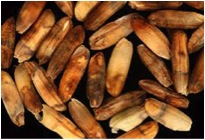Agricultural crops :: Cereals :: Rice
Grain discolouration
Casual Organism :
Drechslera oryzae, D. rostratum, D.tetramera, Curvularia lunata, Trichoconis padwickii, Sarocladium oryzae, Alternaria tenuis, Fusarium moniliforme, Cladosporium herbarum, Epicoccum purpurascens, Cephalosporium sp., Phoma sp. and Nigrospora sp. are associated with the discoloured grains.
Symptoms:
- The grains may be infected by various organisms before or after harvesting causing discolouration, the extend of which varies according to season and locality.
- The infection may be external or internal causing discoloration of the glumes or kernels or both.
- Dark brown or black spots appear on the grains.
- The discolouration may be red, yellow, orange, pink or black, depending upon the organism involved and the degree of infection.
- This disease is responsible for quantitative and qualitative losses of grains.
|
 |
| GRAIN DISCOLOURATION |
|
Favourable Conditions:
- High humidity and cloudy weather during heading stage.
Mode of Spread and Survival:
- The disease spreads mainly through air-borne conidia and the fungus survives as parasite and saprophyte in the infected grains, plant debris and also on other crop debris.
Management:
- Pre and post-harvest measures should be taken into account for prevention of grain discolouration.
- Foliar spray of Neem oil @ 3 per cent at 50 % flowering stage followed by second spray 10 days later.
- Seed treatment with Bacillus subtilis @ 10g/kg + one foliar spray with Azoxystrobin @ 100 ml/ac
at 50 per cent flowering for the management of sheath rot and grain discolouration.
Source of information:
- AICRIP rice, TNAU, Coimbatore, Rice diseases- online resource, IRRI, Phillippines.
Acknowledgements:
|
|

